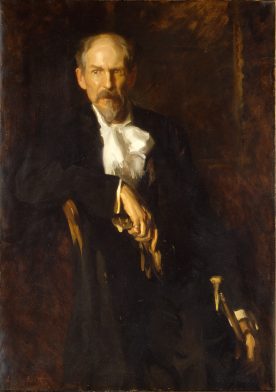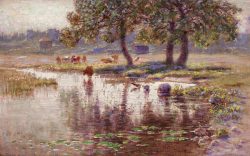Louis Betts, James William Pattison, 1906, oil on canvas (47¾ by 33⅞ inches), collection of the Union League Club of Chicago, UL1976.4.

James William Pattison 1844–1915
James William Pattison was born in Boston, the son of the principal of Oread Institute, a women’s college in Worcester, Massachusetts. He enlisted in the Union Army late in the Civil War and published sketches of the conflict in Harper’s Weekly. At war’s end, Pattison studied art privately in St. Louis, where he married his first wife. By 1866, he was in New York, taking instruction in landscape painting from either Sanford or R. Swain Gifford, the brothers William and James M. Hart, and George Inness. After five years as an art instructor at Washington University in St. Louis, Pattison went to Düsseldorf, Germany, for further training. In 1876, the widowed Pattison married fellow artist Helen Searle. The couple lived in Paris, where he was represented in the Salon exhibitions of 1879, 1880, and 1881.
After two years’ residence in New York, where Pattison exhibited at the National Academy of Design and with the American Water Color Society, he became director of the School of Fine Arts in Jacksonville, Illinois. Widowed once more, Pattison moved to Chicago in 1896 to take up a lecturing position at the Art Institute of Chicago; he also taught art at Rockford College, in Rockford, Illinois. Pattison was active in Chicago’s Municipal Art League and other local organizations. He lived in the Tree Studios building on Chicago’s Near North Side until 1906, when he moved with his third wife, whom he had married the year before, to suburban Park Ridge. His neighbors there included painter Walter Marshall Clute, who in 1906 published a profile of Pattison in the Chicago-based journal The Sketch Book. In 1907 the Municipal Art League acquired Pattison’s best-known painting, Tranquility (circa 1906; Union League Club of Chicago). The artist found subjects for landscape and marine paintings in France and in coastal New England, where he often summered, and he made romantic nighttime views of New York City seen from the water. He also specialized in studies of animals, particularly sheep. In addition to oils, Pattison worked in watercolors and made etchings. Until 1910 he exhibited his art nationally and with such local organizations as the Society of Western Artists and the Chicago Society of Artists, of which he was a longtime officer.
Pattison was equally prominent as a writer on art, beginning in 1886 with his serial “Pattison’s Art Talks” in the Jacksonville Journal and the Chicago Journal. He contributed to Arts for America (later The Arts), the journal of the Chicago-based Central Art Association, and he wrote criticism for local newspapers and national magazines. He also published several books on painters from the Renaissance to modern times, in addition to editing the journal The Fine Arts in 1910. Pattison retired to Ashville, North Carolina, after 1912 and died there at the age of seventy.
Wendy Greenhouse, PhD
